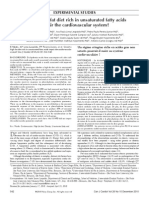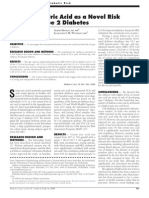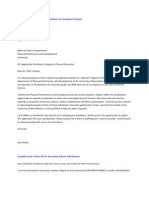A Changing View On Sfas and Dairy: From Enemy To Friend: Editorial
A Changing View On Sfas and Dairy: From Enemy To Friend: Editorial
Uploaded by
Caio Whitaker TosatoCopyright:
Available Formats
A Changing View On Sfas and Dairy: From Enemy To Friend: Editorial
A Changing View On Sfas and Dairy: From Enemy To Friend: Editorial
Uploaded by
Caio Whitaker TosatoOriginal Title
Copyright
Available Formats
Share this document
Did you find this document useful?
Is this content inappropriate?
Copyright:
Available Formats
A Changing View On Sfas and Dairy: From Enemy To Friend: Editorial
A Changing View On Sfas and Dairy: From Enemy To Friend: Editorial
Uploaded by
Caio Whitaker TosatoCopyright:
Available Formats
AJCN. First published ahead of print October 29, 2014 as doi: 10.3945/ajcn.114.099986.
Editorial
A changing view on SFAs and dairy: from enemy to friend1–3
Arne Astrup
Almost all national dietary guidelines recommend a reduction in acid supplementation. In the observational studies, RRs for
SFAs as a key intervention to reduce incidence and mortality of coronary disease were no different for SFAs, n–6 PUFAs, and
cardiovascular disease (CVD). This has been translated into advice MUFAs when the top and bottom thirds of baseline dietary fatty
to reduce the intake of the major sources of SFAs, that is, dairy acid intake or circulating fatty acids were compared. The meta-
produce, meat products, and eggs. However, recent meta-analyses analysis of RCTs with hard CVD endpoints reached the same
of both observational studies and randomized controlled trials not conclusion. Another meta-analysis of RCTs even suggested that
only have raised doubts about the scientific substantiation for this replacement of SFAs with pure n–6 PUFAs might increase CVD
advice but have actually undermined it. It has become clear that risk and mortality (5).
there is a need for a completely different approach, with advice that
is based on foods rather than on nutrients. DAIRY AND RISK OF CVD AND TYPE 2 DIABETES
The evidence to support reducing SFAs rests on a 2-step argu-
ment: ‘‘A strong body of evidence indicates that higher intake of In recent years, a substantial body of research has investigated
most dietary SFA (A) is associated with higher levels of blood the effects of dairy and dairy fat on risks of CVD, type 2 diabetes,
total cholesterol and low-density lipoprotein (LDL) cholesterol and obesity. A dose-response meta-analysis of prospective stud-
(B). Higher total and LDL cholesterol levels (B) are risk factors ies indicates that milk intake is not associated with total mortality
for CVD (C)’’ (1). but may be inversely associated with overall CVD risk (6).
Most would interpret the statement above as evidence of Reliance on self-reported dietary intakes poses substantial
a causal relation between intake of SFAs (A) and CVD (C), problems with validity, and the development of objective bio-
but it is actually an assumption that increased concentrations markers to distinguish between different food-derived fatty
of LDL cholesterol (B) will always increase the risk of CVD acids represents a major advantage; pentadecanoic acid (15:0),
(C). The relation between dietary fats (and other dietary compo- heptadecanoic acid (17:0), and trans palmitoleic acid (trans
nents) and CVD is, however, much more complex, and this 16:1n–7) can be used as biomarkers for dairy intake. The liter-
assumption does not take into account the importance of LDL- ature has generated mixed results with regard to risk of stroke,
cholesterol particle size, effects on HDL cholesterol, and other but the most comprehensive study from 2 large U.S. cohorts
mediators of the atherosclerotic, thrombotic, and thrombolytic (Health Professionals Follow-Up Study: 51,529 men; Nurses’
processes (2). Health Study: 121,700 women) using biomarkers of dairy fat
(pentadecanoic acid, heptadecanoic acid, and trans palmitoleic
acid) reports results for stroke in this issue of the Journal (7).
SFAs AND CVD After relevant adjustments, no significant associations with total
More recent meta-analyses of high compared with low intakes stroke were seen for any of the 3 biomarkers. The results were
of SFAs fail to find any increased CVD risk. Siri-Tarino et al. (3) similar for ischemic and hemorrhagic stroke subtypes, and the
compared extreme quantiles of SFA intake and found RRs not results remained in sensitivity analyses.
different from 1.0. However, it has become obvious that the SFAs have also been associated with increased risk of type 2 di-
different fatty acids derived from different foods do not have abetes, which is a major risk factor for CVD. However, meta-
the same biological effects, and that the food matrix within analyses of observational studies based on self-reported dietary
which they are delivered modifies their effect. So the health intake failed to find that dairy increases the risk of type 2 diabetes
effects of any food matrix rich in SFAs cannot be predicted on (8, 9). In a meta-analysis of 17 cohort studies, there was a modest but
the basis of the content of ‘‘total SFAs’’ given on the nutrient significant inverse relation between intakes of total dairy products,
content label. There is a need to view the health effect of ‘‘whole low-fat dairy products, and cheese and risk of type 2 diabetes (9).
foods’’ and to use biomarkers to improve the validity of the 1
From the Department of Nutrition, Exercise, and Sports, Faculty of
habitual food intake registered in observational studies and ad-
Science, University of Copenhagen, Frederiksberg, Denmark.
herence in RCTs. 2
No financial support was received for this editorial.
Chowdhury et al. (4) examined the effect of SFAs based on 3
Address correspondence to A Astrup, Nørre Alle 51, Copenhagen, Denmark,
a meta-analysis of 17 observational studies with fatty acid bio- DK-2200. E-mail: ast@nexs.ku.dk.
markers and 27 randomized controlled trials (RCTs) of fatty doi: 10.3945/ajcn.114.099986.
Am J Clin Nutr doi: 10.3945/ajcn.114.099986. Printed in USA. Ó 2014 American Society for Nutrition 1 of 2
Copyright (C) 2014 by the American Society for Nutrition
2 of 2 EDITORIAL
BIOMARKERS OF DAIRY AND DIABETES RISK tional food companies/organizations, including The Danish Dairy Research
Council, Arla Foods AS, and the Global Dairy Platform. AA currently serves
A case-cohort analysis was conducted based on the European
as consultant/member of advisory boards for the Global Dairy Platform, USA;
Prospective Investigation into Cancer and Nutrition–InterAct McCain Foods Ltd., USA; and McDonald’s, USA. He is recipient of honoraria
study in 12,403 individuals with incident type 2 diabetes, and and sponsorship of congress attendance as a speaker for a wide range of Dan-
fatty acids were measured in plasma phospholipids (10). ish and international concerns.
Whereas even-chain SFAs were positively associated with in-
cident type 2 diabetes, the odd-chain SFAs pentadecanoic acid
and heptadecanoic acid were inversely associated with incident REFERENCES
type 2 diabetes (HRs: 0.79 and 0.67, respectively). However, 1. USDA; U.S. Department of Health and Human Services. Dietary guide-
whereas this study adds further to evidence of a diabetes- lines for Americans, 2010. 7th ed. Washington: U.S. Government Print-
protective effect of dairy products, it does not present any ing Office; 2010.
2. Astrup A, Dyerberg J, Elwood P, Hermansen K, Hu FB, Jakobsen MU,
mechanism nor does it provide information about whether it Kok FJ, Krauss RM, Lecerf JM, LeGrand P, et al. The role of reducing
is the SFAs or other components within the food matrix of intake of SFA in the prevention of cardiovascular disease: where does
dairy that mediate the effects. In contrast, also in this issue the evidence stand in 2010? Am J Clin Nutr 2011;93:684–8.
of the Journal, Santaren et al. (11) confirm that serum concen- 3. Siri-Tarino PW, Sun Q, Hu FB, Krauss RM. Meta-analysis of prospec-
tive cohort studies evaluating the association of saturated fat with car-
trations of pentadecanoic acid were associated with a 27% risk diovascular disease. Am J Clin Nutr 2010;91:535–46.
of diabetes (OR: 0.73; P ¼ 0.02), and the association remained 4. Chowdhury R, Warnakula S, Kunutsor S, Crowe F, Ward HA, Johnson
after adjustment for BMI and waist circumference. This sug- L, Franco OH, Butterworth AS, Forouhi NG, Thompson SG, et al.
gests that the effect is independent of body fatness, an important Association of dietary, circulating, and supplement fatty acids with cor-
onary risk: a systematic review and meta-analysis. Ann Intern Med
cause of type 2 diabetes. Santaren et al. also used frequently 2014;160:398–406.
sampled intravenous glucose tolerance tests to measure insulin 5. Ramsden CE, Zamora D, Leelarthaepin B, Majchrzak-Hong SF, Faurot
sensitivity (SI) and b cell function (Disposition Index), and they KR, Suchindran CM, Ringel A, Davis JM, Hibbeln JR. Use of dietary
found that concentrations of pentadecanoic acid were positively linoleic acid for secondary prevention of coronary heart disease and
death: evaluation of recovered data from the Sydney Diet Heart Study
associated with both measures in fully adjusted models. These and updated meta-analysis. BMJ 2013;346:e8707.
associations were substantially weakened by adjustment for 6. Soedamah-Muthu SS, Ding EL, Al-Delaimy WK, Hu FB, Engberink MF,
obesity indexes. The authors correctly state that the mechanism Willett WC, Geleijnse JM. Milk and dairy consumption and incidence
underlying the inverse relation of pentadecanoic acid with di- of cardiovascular diseases and all-cause mortality: dose-response
meta-analysis of prospective cohort studies. Am J Clin Nutr 2011;
abetes risk is not known, and that it could be either an effect of 93:158–71.
fatty acid or attributable to other beneficial components within 7. Yakoob MY, Shi P, Hu FB, Campos H, Rexrode KM, Orav EJ, Willett
the dairy matrix. WC, Mozaffarian D. Circulating biomarkers of dairy fat and risk of
incident stroke among US men and women in 2 large prospective co-
horts. Am J Clin Nutr 2014;100:1437–47.
CONCLUSIONS 8. Gao D, Ning N, Wang C, Li Q, Meng Z, Liu Y, Li Q. Dairy products
consumption and risk of type 2 diabetes: systematic review and dose-
The totality of evidence does not support that dairy SFAs in- response meta-analysis. PLoS ONE 2013;8:e73965.
crease the risk of coronary artery disease or stroke or CVD 9. Aune D, Norat T, Romundstad P, Vatten LJ. Dairy products and the risk
mortality. In contrast, lean dairy is clearly associated with de- of type 2 diabetes: a systematic review and dose-response meta-analysis
of cohort studies. Am J Clin Nutr 2013;98:1066–83.
creased risk of type 2 diabetes, and this effect is partly indepen- 10. Forouhi NG, Koulman A, Sharp SJ, Imamura F, Kröger J, Schulze MB,
dent of any effect of body fat loss. In addition, lean dairy does Crowe FL, Huerta JM, Guevara M, Beulens JWJ, et al. Differences in the
not increase body fatness but tends to preserve lean body tissue. prospective association between individual plasma phospholipid saturated
There is no evidence left to support the existing public health fatty acids and incident type 2 diabetes: the EPIC-InterAct case-cohort
study. Lancet Diabetes Endocrinol 2014 Aug 6 (Epub ahead of print; DOI:
advice to limit consumption of dairy to prevent CVD and type 10.1016/S2213-8587(14)70146-9).
2 diabetes. Cheese and other dairy products are, in fact, nutrient- 11. Santaren ID, Watkins SM, Liese AD, Wagenknecht LE, Rewers MJ,
dense foods that give many people pleasure in their daily meals. Haffner SM, Lorenzo C, Hanley AJ. Serum pentadecanoic acid (15:0),
a short-term marker of dairy food intake, is inversely associated with
The Department of Nutrition, Exercise and Sports at the University of incident type 2 diabetes and its underlying disorders. Am J Clin Nutr
Copenhagen receives research support from numerous Danish and interna- 2014;100:1532–40.
You might also like
- R (Student Book)Document17 pagesR (Student Book)Ass Ssadfsf100% (9)
- Evidence-Based Practice - Nursing Test QuestionsDocument18 pagesEvidence-Based Practice - Nursing Test QuestionsRNStudent1100% (8)
- Travel Cover 2023 11 16 13 39 13 71Document1 pageTravel Cover 2023 11 16 13 39 13 71segunsannyNo ratings yet
- Coaching and MentoringDocument33 pagesCoaching and MentoringSiddharth ManuNo ratings yet
- Association of Dietary, Circulating, and Supplement Fatty Acids With Coronary RiskDocument7 pagesAssociation of Dietary, Circulating, and Supplement Fatty Acids With Coronary RiskVitor CordeiroNo ratings yet
- 4.petimar NursesHealthStudyDocument12 pages4.petimar NursesHealthStudycip.coordinaciondocenteNo ratings yet
- 5 FullDocument13 pages5 FullVampaneZe ヴァンパネゼ ShuichiNo ratings yet
- Dietary Saturated Fats and Their Food Sources in Relation To The RiskDocument8 pagesDietary Saturated Fats and Their Food Sources in Relation To The RiskJohn SammutNo ratings yet
- Adv Writing 2Document4 pagesAdv Writing 2api-381700037No ratings yet
- Egg Consumption in Relation To Cardiovascular Disease and Mortality: The Physicians' Health StudyDocument6 pagesEgg Consumption in Relation To Cardiovascular Disease and Mortality: The Physicians' Health Studykrazyj123No ratings yet
- Excess Protein Intake Relative To Fiber and Cardiovascular Events in Elderly Men With Chronic Kidney DiseaseDocument6 pagesExcess Protein Intake Relative To Fiber and Cardiovascular Events in Elderly Men With Chronic Kidney Diseaseluis Gomez VallejoNo ratings yet
- Saturated Fat and Heart Disease American Journal of Clinical NutritionDocument12 pagesSaturated Fat and Heart Disease American Journal of Clinical Nutritionjackjensen2852No ratings yet
- Artigo Base TrabalhoDocument11 pagesArtigo Base Trabalhoiagosimon05No ratings yet
- Lectura Complementaria Carnes Rojas y Procesadas y Riesgos para La SaludDocument7 pagesLectura Complementaria Carnes Rojas y Procesadas y Riesgos para La SaludShayAlarcónNo ratings yet
- Dairy Fat Intake Is Associated With Glucose Tolerance, Hepatic and Systemic Insulin Sensitivity, and Liver Fat But Not B-Cell Function in HumansDocument12 pagesDairy Fat Intake Is Associated With Glucose Tolerance, Hepatic and Systemic Insulin Sensitivity, and Liver Fat But Not B-Cell Function in HumansConciencia CristalinaNo ratings yet
- J Jacc 2020 05 077Document45 pagesJ Jacc 2020 05 077Lars Fernández RodríguezNo ratings yet
- C-Dieta10añosStero 230217 100842Document9 pagesC-Dieta10añosStero 230217 100842Juan Carlos Plácido OlivosNo ratings yet
- Dietary Protein Sources and Risk For Incident Chronic Kidney Disease - Results From The Atherosclerosis Risk in Communities (ARIC) StudyDocument10 pagesDietary Protein Sources and Risk For Incident Chronic Kidney Disease - Results From The Atherosclerosis Risk in Communities (ARIC) StudynuvitaNo ratings yet
- Glycemic Index, Glycemic Load, and Blood Pressure: A Systematic Review and Meta-Analysis of Randomized Controlled TrialsDocument15 pagesGlycemic Index, Glycemic Load, and Blood Pressure: A Systematic Review and Meta-Analysis of Randomized Controlled TrialsLisiane PerinNo ratings yet
- Stoke NutritionDocument14 pagesStoke Nutritionapi-150223943No ratings yet
- Obesidade Rio de JaneiroDocument7 pagesObesidade Rio de JaneiroarianeoliNo ratings yet
- Prospective Investigation of Major Dietary PatternsDocument7 pagesProspective Investigation of Major Dietary PatternsJohn SammutNo ratings yet
- 1111Document20 pages1111api-326476970No ratings yet
- Pimpin Buttersystemtaticreviewandmeta PlosOne 2016Document19 pagesPimpin Buttersystemtaticreviewandmeta PlosOne 2016Nguyen Minh TrongNo ratings yet
- Prospective Study of Major Dietary Patterns and Risk of CoronaryDocument10 pagesProspective Study of Major Dietary Patterns and Risk of CoronaryJohn SammutNo ratings yet
- Raman, G 2019Document12 pagesRaman, G 2019Nicolás MurilloNo ratings yet
- Dietary Fat and Coronary Heart Disease - Summary of Evidence From Prospective Cohort and Random Is Ed Controlled TrialsDocument29 pagesDietary Fat and Coronary Heart Disease - Summary of Evidence From Prospective Cohort and Random Is Ed Controlled Trialsa_rogall7926No ratings yet
- Dietary Protein and Risk of Ischemic Heart Disease in Middle-Aged Men1-3 Sarah Rosner PDocument8 pagesDietary Protein and Risk of Ischemic Heart Disease in Middle-Aged Men1-3 Sarah Rosner Ppaulobrasil.ortopedistaNo ratings yet
- 1 s2.0 S0002870320302143 MainDocument9 pages1 s2.0 S0002870320302143 MaindeepNo ratings yet
- Adherence To A Healthy Diet in Relation To Cardiovascular Incidence and Risk Markers - Evidence From The Caerphilly Prospective StudyDocument14 pagesAdherence To A Healthy Diet in Relation To Cardiovascular Incidence and Risk Markers - Evidence From The Caerphilly Prospective StudyXochitl PonceNo ratings yet
- Yogurt Presión ArterialDocument9 pagesYogurt Presión ArterialCarlos MendozaNo ratings yet
- Actividad-Comites 78 0Document9 pagesActividad-Comites 78 0mnc.ramosNo ratings yet
- Milk and Dairy Product Consumption and Cardiovascular Diseases: An Overview of Systematic Reviews and Meta-AnalysesDocument26 pagesMilk and Dairy Product Consumption and Cardiovascular Diseases: An Overview of Systematic Reviews and Meta-AnalysesLeandro AisaNo ratings yet
- ECV y Genetica RiesgoDocument9 pagesECV y Genetica RiesgoLic. Monica Bamonde NutricionistaNo ratings yet
- ,content, 31,2,361 FullDocument2 pages,content, 31,2,361 FullMilka MimingNo ratings yet
- Association of Dietary Fatty Acids With Coronary RiskDocument17 pagesAssociation of Dietary Fatty Acids With Coronary Riskubiktrash1492No ratings yet
- Pi Is 2666776224001157Document12 pagesPi Is 2666776224001157daniel dmelloNo ratings yet
- Whole Milk Intake Is Associated With Prostate Cancer-Specific Mortality Among U.S. Male PhysiciansDocument8 pagesWhole Milk Intake Is Associated With Prostate Cancer-Specific Mortality Among U.S. Male PhysiciansSeren ModNo ratings yet
- Wu Et Al., 2022 Association - Dietary - Spermidine - All-Cause - MortalityDocument9 pagesWu Et Al., 2022 Association - Dietary - Spermidine - All-Cause - MortalityPatrícia Felix ÁvilaNo ratings yet
- ChocolateDocument6 pagesChocolatereyes.campos.abogadosNo ratings yet
- Dieta y CancerDocument11 pagesDieta y CancerJose Angel AbadíaNo ratings yet
- REVIEW - Legume-Consumption-And-Cvd-Risk-A-Systematic-Review-And-Meta-AnalysisDocument10 pagesREVIEW - Legume-Consumption-And-Cvd-Risk-A-Systematic-Review-And-Meta-AnalysisLaiane GomesNo ratings yet
- Review Article Effect of The Dietary Fat Quality On Insulin SensitivityDocument9 pagesReview Article Effect of The Dietary Fat Quality On Insulin SensitivityGilberto BicalhoNo ratings yet
- Types of Dietary Fat and Risk of Coronary Heart Disease: A Critical ReviewDocument15 pagesTypes of Dietary Fat and Risk of Coronary Heart Disease: A Critical ReviewMegan KnightNo ratings yet
- Cardio Metabolic Effects of High Fat DietsDocument18 pagesCardio Metabolic Effects of High Fat DietsGarrett JacksonNo ratings yet
- Egg Consumption and Risk of Incident Type 2 Diabetes in Men: The Kuopio Ischaemic Heart Disease Risk Factor StudyDocument9 pagesEgg Consumption and Risk of Incident Type 2 Diabetes in Men: The Kuopio Ischaemic Heart Disease Risk Factor StudyMatías RamírezNo ratings yet
- Fried-Food Consumption and Risk of Type 2 DiabetesDocument10 pagesFried-Food Consumption and Risk of Type 2 DiabetesNguyen Minh TrongNo ratings yet
- Nutrients 10 01385Document16 pagesNutrients 10 01385Alex GutiérrezNo ratings yet
- 2020 Yogurt Consumption in Relation To Mortality From Cardiovascular Disease Cancer and All Causes A Prospective Investigation in 2 Cohorts of US Women and Men Am J Clin NutrDocument9 pages2020 Yogurt Consumption in Relation To Mortality From Cardiovascular Disease Cancer and All Causes A Prospective Investigation in 2 Cohorts of US Women and Men Am J Clin Nutrmicheangello HchNo ratings yet
- Breakfast Skipping and CADDocument5 pagesBreakfast Skipping and CADadip royNo ratings yet
- 1 s2.0 S0002916522012357 MainDocument9 pages1 s2.0 S0002916522012357 MainSalvia Elvaretta HarefaNo ratings yet
- Red Meat Consumption and Risk of Stroke in Swedish MenDocument5 pagesRed Meat Consumption and Risk of Stroke in Swedish MenJohn SammutNo ratings yet
- Saturated Fats and Health: A Reassessment and Proposal For Food-Based RecommendationsDocument14 pagesSaturated Fats and Health: A Reassessment and Proposal For Food-Based RecommendationsMónika BokorNo ratings yet
- Busting The Myth of Saturated Fat in Heart Disease British Medical Journal 2013Document2 pagesBusting The Myth of Saturated Fat in Heart Disease British Medical Journal 2013jackjensen2852No ratings yet
- 2016 Lacroix S Nutrition in CV RehabDocument7 pages2016 Lacroix S Nutrition in CV RehabHumamuddinNo ratings yet
- Vegetarian Diet, Seventh Day Adventists and Risk of CardiovascularDocument7 pagesVegetarian Diet, Seventh Day Adventists and Risk of CardiovascularJohn SammutNo ratings yet
- Ingestão de Ovos e ColesterolDocument7 pagesIngestão de Ovos e Colesterolqmatheusq wsantoswNo ratings yet
- Dietary Fat Assessing The Evidence in Support of A Moderate Fat Diet The Benchmark Based On Lipoprotein MetabolismDocument12 pagesDietary Fat Assessing The Evidence in Support of A Moderate Fat Diet The Benchmark Based On Lipoprotein Metabolismabdul335139No ratings yet
- Am J Clin Nutr 2015 Virtanen 1088 96Document9 pagesAm J Clin Nutr 2015 Virtanen 1088 96Marko BrzakNo ratings yet
- By Guest On 26 April 2018Document8 pagesBy Guest On 26 April 2018silvanaNo ratings yet
- Old Study Sheds New Light On The Fatty Acids and Cardiovascular Health DebateDocument2 pagesOld Study Sheds New Light On The Fatty Acids and Cardiovascular Health DebatemreadesNo ratings yet
- Nutrition PDFDocument2 pagesNutrition PDFCamila BonillaNo ratings yet
- Hypoglycemia in Diabetes: Pathophysiology, Prevalence, and PreventionFrom EverandHypoglycemia in Diabetes: Pathophysiology, Prevalence, and PreventionNo ratings yet
- Assessment of Medical Records System Towards Ensuring Confidentiality of Patients Records Case Study of Medical Records Department in Federal Medical Centre, Ebute-Metta, Lagos, Nigeria.Document22 pagesAssessment of Medical Records System Towards Ensuring Confidentiality of Patients Records Case Study of Medical Records Department in Federal Medical Centre, Ebute-Metta, Lagos, Nigeria.International Journal of Innovative Science and Research Technology100% (1)
- 04 Neurocortex Merzenich Et Al PDFDocument28 pages04 Neurocortex Merzenich Et Al PDFJosé Antonio GarcíaNo ratings yet
- FCEM (SA) Part II Past Papers - 2012 Sept 22-1-2014Document7 pagesFCEM (SA) Part II Past Papers - 2012 Sept 22-1-2014matentenNo ratings yet
- Simon Schaffer (Studies in History and Philosophy of Science Part A Volume 22 Issue 1 1991) The Pasteurization of France - Bruno Latour, Translated by Alan Sheridan and John LawDocument19 pagesSimon Schaffer (Studies in History and Philosophy of Science Part A Volume 22 Issue 1 1991) The Pasteurization of France - Bruno Latour, Translated by Alan Sheridan and John LawJhonny Castillo100% (1)
- How To Write A Letter of Application For Graduate SchoolsDocument3 pagesHow To Write A Letter of Application For Graduate SchoolsJacky Boy Endencio AtienzaNo ratings yet
- Salinan Dari Jadwal KF Kedung CowekDocument47 pagesSalinan Dari Jadwal KF Kedung Cowekdwikamaliyatissholehah94No ratings yet
- Medicinal PlantsDocument39 pagesMedicinal PlantsVinayak Khairnar67% (3)
- Guidelines For PhysiciansDocument34 pagesGuidelines For PhysiciansSajid KhanNo ratings yet
- What Is Carnation Essential Oil?: About Carnation (Dianthus Caryophyllus Linn. Cv. Grenadin)Document9 pagesWhat Is Carnation Essential Oil?: About Carnation (Dianthus Caryophyllus Linn. Cv. Grenadin)Sabina FurešNo ratings yet
- DR Sandeep Dewan Webinar InvitationDocument3 pagesDR Sandeep Dewan Webinar InvitationShehbaz ThakurNo ratings yet
- The Twist Walkthrough 0.31 BetaDocument52 pagesThe Twist Walkthrough 0.31 BetaMario MaurerNo ratings yet
- Medical-Surgical Nursing Assessment and Management of Clinical Problems 9e Chapter 40Document9 pagesMedical-Surgical Nursing Assessment and Management of Clinical Problems 9e Chapter 40sarasjunkNo ratings yet
- Children Served ProfileDocument1 pageChildren Served ProfileMonteza Dela Serna100% (4)
- AFR Conference - Mumbai - CII - FinalDocument65 pagesAFR Conference - Mumbai - CII - FinalRaja Rao KamarsuNo ratings yet
- Miss Evers Boys FinalDocument2 pagesMiss Evers Boys Finalapi-290927558No ratings yet
- Rheumatic Fever Small Group DiscussionDocument13 pagesRheumatic Fever Small Group DiscussionLyca Mae AurelioNo ratings yet
- Glyphosate-41SL 2Document6 pagesGlyphosate-41SL 2Mostafa Fawzy100% (1)
- Final Examination With Answers and RationalesDocument114 pagesFinal Examination With Answers and RationalesMonicaNo ratings yet
- Greywater Filtration Systems: For A Sustainable Water CultureDocument36 pagesGreywater Filtration Systems: For A Sustainable Water CultureJen Beatrice DiazNo ratings yet
- Head and Neck Assessment NursingDocument8 pagesHead and Neck Assessment NursingNicks NacarioNo ratings yet
- Mary Johnston Hospital: Philhealth AccreditedDocument1 pageMary Johnston Hospital: Philhealth AccreditedfilchibuffNo ratings yet
- Group 1 ResearchDocument16 pagesGroup 1 ResearchShie JMNo ratings yet
- Tri-City Times: Incident Closes City HallDocument26 pagesTri-City Times: Incident Closes City HallWoodsNo ratings yet
- Diagnostic in Pulmonary Emergency and Respiratory Problem 2020 PDFDocument43 pagesDiagnostic in Pulmonary Emergency and Respiratory Problem 2020 PDFIzka P RahmaniaNo ratings yet
- Chief Legal Officer SurveyDocument65 pagesChief Legal Officer SurveySankar Nath ChakrabortyNo ratings yet
- Case Study Lung Adenocarcinoma PDFDocument43 pagesCase Study Lung Adenocarcinoma PDFFrancis Anthony LoslosoNo ratings yet

























































































